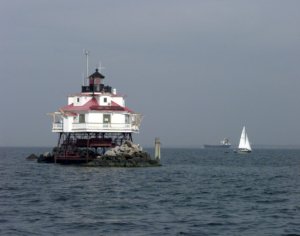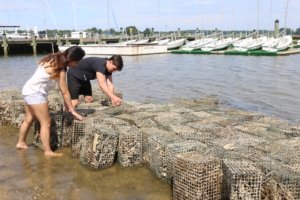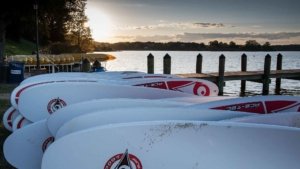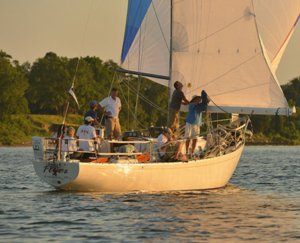As a waterfront community, St. Mary’s College of Maryland prides itself on the health and wellbeing of Horseshoe Bend – our own little neck of the St. Mary’s River!
The Key to Our Community
Our waterfront landscape hosts several major events each year, including the Annual Governor’s Cup Yacht Race from Annapolis to St. Mary’s City and the Great Bamboo Race on Family Weekend. Plus, our sailing team is one of the best in the nation, boasting fifteen national championships!
But the river is more than just a source of leisure and recreation. As a waterfront collegiate community, much of our history, culture, and ecology depend on the wellbeing of the St. Mary’s River.
The Office of Sustainability therefore commits itself to preserving this treasure through educational and conservation efforts. We believe it is the responsibility of the St. Mary’s College of Maryland community to take action in preserving the St. Mary’s River we call home.
Our Bridge to the Chesapeake Bay

Chesapeake Bay, Md. (Nov. 11) — A sailboat cruises by Thomas Point Lighthouse in the Chesapeake Bay. USCG photo by PA1 Pete Milnes.
The St. Mary’s River serves as our connection to the greater Chesapeake Bay watershed. The Chesapeake Bay is home to over 3,500 species of plants and animals, including the iconic oyster, blue crab, rockfish, and seahawk.
Unfortunately, the wellbeing of the Chesapeake Bay continues to decline at the hand of agricultural pollution, industrial waste, and over-harvesting. Oyster beds are one of the many populations suffering in the bay’s present state. Although the name “Chesapeake” means “great shellfish bay,” just 1% of the native oyster population remains in the bay today.
The Office of Sustainability encourages environmental stewardship of the Chesapeake Bay and the St. Mary’s River that feeds it. Many of our students and faculty complete cutting-edge research along these precious watersheds. We encourage members of the St. Mary’s community to lead eco-friendly lives, whether through personal lifestyle choices or by getting involved in the community / on campus.
Restoring Horseshoe Bend 
Our small bend in the St. Mary’s River has undergone an extensive amount of restoration in the past few decades. St. Mary’s College of Maryland is committed to the preservation and restoration of Horseshoe Bend and is proud to boast of the following restoration projects.
The St. Mary’s River Project
The St. Mary’s River Project, led by Dr. Robert Paul and Dr. Chris Tanner of the St. Mary’s College Biology Department, closely monitors the water quality and ecological health of the St. Mary’s River. The project began in June of 1999 under a grant from the Environmental Protection Agency.
Over the years, dozens of students, faculty, and local scientists have contributed to research for the project, resulting in numerous scientific publications. Currently, the environmental outreach of the St. Mary’s River Project continues as an educational program for local fifth graders.
St. Mary’s Watershed Association
The St. Mary’s River Watershed Association spearheads a number of important projects to restore the natural habitat of Horseshoe Bend. SMRWA recently installed oyster shells and reef balls along the bottom of Horseshoe Bend in an effort to stabilize the riverbed. The shells were created and installed by interns from St. Mary’s College. Shore Thing Shellfish, a local oyster company comprised of three St. Mary’s alumni, supplied the shell and labor for this endeavor.
Student Initiatives
Students have shown their dedication to the St. Mary’s River by conducting a number of research-based St. Mary’s Projects (SMP’s) on the health and restoration of the Bend. SMP’s are a capstone thesis project required by most majors at St. Mary’s
Ecology-based projects often focus on the oyster populations and underwater grasses living in the St. Mary’s River. Students from other disciplines, including Chemistry, Biochemistry, and English, have also generated projects focused on the health and restoration of the St. Mary’s River.
Get Involved
There are many local marine conservation agencies working to preserve the St. Mary’s River and Chesapeake Bay. Check out our Get Involved page for for information about contributing to local community efforts.
For more information about getting involved on campus, contact our Sustainability Fellow.

